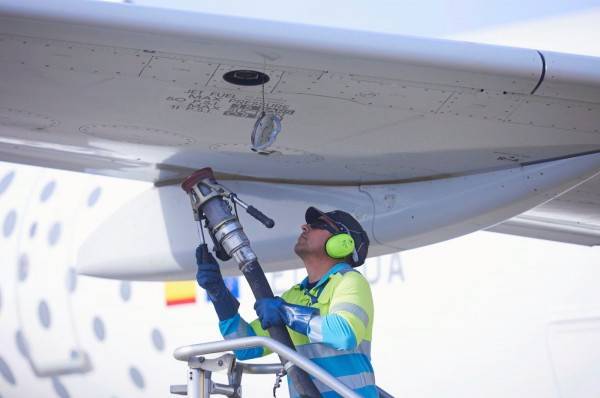- English
- Español
- Português
- русский
- Français
- 日本語
- Deutsch
- tiếng Việt
- Italiano
- Nederlands
- ภาษาไทย
- Polski
- 한국어
- Svenska
- magyar
- Malay
- বাংলা ভাষার
- Dansk
- Suomi
- हिन्दी
- Pilipino
- Türkçe
- Gaeilge
- العربية
- Indonesia
- Norsk
- تمل
- český
- ελληνικά
- український
- Javanese
- فارسی
- தமிழ்
- తెలుగు
- नेपाली
- Burmese
- български
- ລາວ
- Latine
- Қазақша
- Euskal
- Azərbaycan
- Slovenský jazyk
- Македонски
- Lietuvos
- Eesti Keel
- Română
- Slovenski
- मराठी
- Srpski језик
Eu: 1.2% of aviation fuel must come from green hydrogen by 2030
2023-10-11

By 2030, 1.2% of aviation fuel in the EU must come from green hydrogen. The proportion of synthetic aviation fuel will increase periodically until it reaches a 35% share by 2050.
After the ReFuelEU Aviation Directive was signed by member states, synthetic aviation fuel derived from green hydrogen must account for 1.2% of the EU's total aviation fuel by 2030.
The EU directive aims to significantly reduce greenhouse gas emissions from aircraft by 2050 by mandating that flights departing from EU airports use an increasing number of bio-based sustainable aviation fuels (SAFs) and green hydrogen-based synthetic e-fuels from 2025.
Demand for green hydrogen is set to soar after EU countries approved mandatory targets for its use in industry and transport. This means that from 2025 onwards, aviation fuels in Europe will need to include a bio-SAF blend of 2%, rising to 6% by 2030 and increasing every five years until reaching 70% by 2050.
At the same time, 1.2 percent of the fuel used by aircraft leaving EU airports in 2030 and 2031 must be made from synthetic kerosene - which is produced by combining green hydrogen with captured carbon dioxide through the Fischer-Tropsch process - rising to 2 percent from 2032 to 2034 and 35 percent by 2050.
The 1.2% figure refers to the average share for the period from January 1, 2030 to December 31, 2031, with a minimum share of 0.7% in each of those two particular years.
Again, the 2% figure represents an average share over a three-year period, but the minimum allowable share is 1.2% per year in 2032 and 2033, although this will rise to the minimum 2% in 2034.
The share of synthetic aviation fuel must reach at least 5% per year from 1 January 2035, rising to 10% from 1 January 2040, 15% from 1 January 2045 and 35% from 1 January 2050.
The EU expects demand for aviation fuel at EU airports to reach about 46 million tonnes by 2030, of which 1.2 per cent is 552,000 tonnes. This amount would require about 92,000 tonnes of green hydrogen and 460,000 tonnes of captured carbon (or about 1.8 million tonnes of CO2).

Aviation fuel suppliers and aircraft operators that do not meet the standards will be subject to fines from "competent authorities" yet to be designated by the Member States - the scale of the financial penalties will be determined in a future European Commission report to be submitted to the Member States by 1 January 2027 (and every four years thereafter).
"In order to ensure a level playing field in the internal market for aviation and to comply with the EU's climate objectives, this Regulation should impose effective, proportionate and dissuasive penalties on aviation fuel suppliers and aircraft operators in the event of non-compliance," the directive explains.
"The severity of the penalties must be proportional to the environmental damage and the damage that the violations cause to the level playing field in the domestic market."
"In imposing fines and other penalties, the authorities should take into account the evolution of aviation fuel and fuel prices during the reporting year and may also take into account the extent of breaches, such as repeated breaches."
The document also states that "the gradual decarbonisation of the EU aviation industry should be supported through incentives that reflect the environmental benefits of the SAF and make it more competitive for aircraft operators".
These incentives can be funded at least in part by fines.
"Using the revenues generated by fines, or the equivalent financial value of these revenues, to support research and innovative projects in the SAF field, the production of SAF or mechanisms that allow the price difference between SAF and conventional aviation fuels to be bridged will contribute to this goal," the directive said.

Influential analyst Michael Liebreich said last week that avionic fuel derived from green hydrogen would be four to five times more expensive than traditional fossil jet fuel and therefore unlikely to meet the 2030 target of 1.2 percent.
The directive will become law 20 days after publication in the Official Journal of the European Union.
The European Council today also signed a separate renewable energy Directive, which includes mandatory targets for 42% of industrial hydrogen to be green by 2030 and 1% of all transport fuels to be renewable fuels of non-biological origin (i.e., green hydrogen or its derivatives) by 2030.





